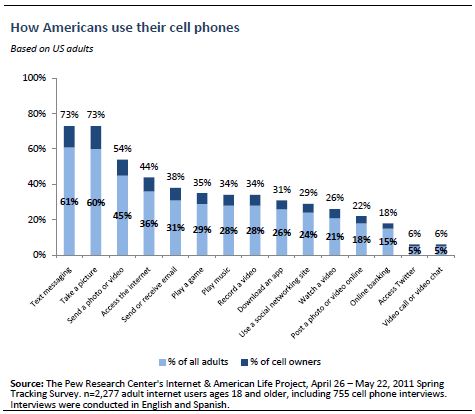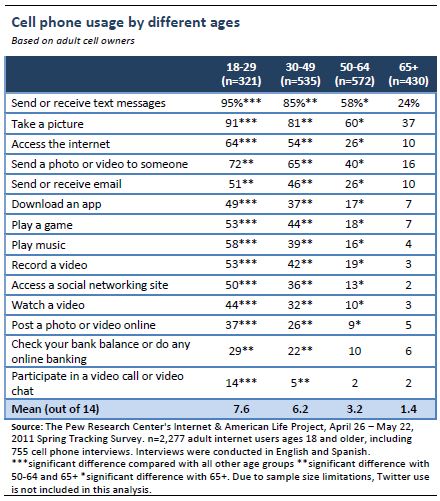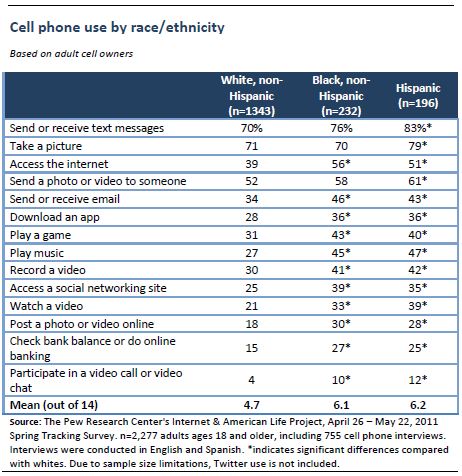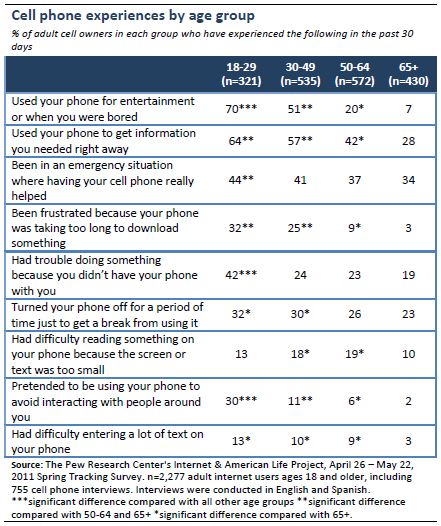Eight in ten American adults (83%) own a cell phone of some kind, and they use their phones for a variety of purposes. As in previous Pew Internet surveys of mobile usage, texting and picture-taking remain the most common mobile phone activities—73% of cell owners engage in each of these—followed by sending photos or videos to others (54%) and accessing the internet (44%). The two least prevalent activities (among the 15 we inquired about) are accessing Twitter and using one’s phone to take part in a video call or chat (6% of cell owners do each of these).

Of the twelve activities that we measured in both May 2010 and May 2011 (we did not ask about online banking, Twitter use or video calling in our spring 2010 survey), five grew by a statistically significant amount over that time period. This growth was primarily oriented around accessing or sharing multimedia content such as photos or videos, as well as using the internet and email:
- Sending a photo or video to someone rose from 36% of cell owners in May 2010 to 54% of cell owners in May 2011
- Accessing the internet—from 38% to 44%
- Sending or receiving email—from 34% to 38%
- Watching a video—from 20% to 26%
- Posting a photo or video online—from 15% to 22%
Younger cell owners (those between the ages of 18 and 29) are especially active mobile users—although those ages 30-49 engage in a relatively wide range of mobile behaviors as well. Mobile usage drops off starting around age 50, as cell owners ages 50-64 engage in roughly half as many activities as those in the 30-49 age group.

Other groups with relatively high levels of mobile usage include:
- Those with some college education or a college degree – These cell owners are more likely to engage in nearly every non-voice application we measured relative to cell owners with a high school diploma or less.
- Urban and suburban residents – Urban and suburban cell owners are more likely than rural cell owners to take part in all of the activities we measured in our survey. Additionally, urban residents are more likely than both rural and suburban dwellers to use their phone to play games (43% of urban cell owners do this), access a social networking site (35%), watch a video (31%), do online banking (25%) or take part in a video call or chat (10%).
- Parents – With some exceptions (such as using social networking sites and video calling), parents of children ages 17 and under are more likely to use their phones for most activities than are other adult cell owners.
- African Americans and Latinos – These groups have high rates of usage, compared with white cell owners, across a wide range of mobile applications.

How Americans view their phones—benefits, challenges and attitudes
In addition to asking about the specific tasks and activities that cell owners engage in using their phones, we included a series of questions in our spring survey asking about various experiences that cell owners have encountered in the course of using their phones. These responses indicate that cell owners value their phones for quick information retrieval, for entertainment, and for assistance in emergency situations. At the same time, a number of cell owners report that they have turned off their phone to get a break from using it, and that they can have trouble accomplishing desired tasks when their phone is not available. In the 30 days preceding our survey:
- 51% of cell owners used their phone to get information they needed right away.
- 42% used their phone for entertainment when they were bored, and 40% were in an emergency situation in which having their phone with them really helped.
- 29% turned their phone off for a period of time just to get a break from using it, and 27% experienced a situation in which they had trouble doing something because they did not have their phone at hand.
- Frustrations with cell phones were somewhat less common, as one in five cell owners (20%) experienced frustration because their phone was taking too long to download something, 16% had difficulty reading something on their phone because the screen was too small, and one in ten (10%) had difficulty entering a lot of text on their phone at some point in the preceding 30 days.
- Just over one in ten cell owners (13%) said that they had pretended to be using their phone in order to avoid interacting with the people around them.
Young cell owners are among the most active users of their mobile devices, and cell owners between the ages of 18 and 29 also stand out from their elders when it comes to their experiences with their phones. Specifically, young cell owners are much more likely than older adults to use their phone for entertainment or to relieve boredom (70% of 18-29 year old cell owners have done this in the preceding 30 days), to have trouble doing something when their phone is not available (42% have experienced this) and to use their phone as a way to avoid interacting with others (30%).
On the other hand, cell owners of all ages are about equally likely to use their phones for assistance in emergency situations, and are also about equally likely to say that they have taken a break from using their phones in the previous 30 days.





